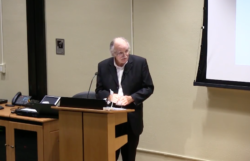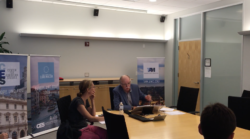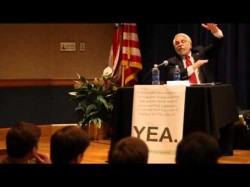Not Working in America: People and Public Policy
The job figures for May were truly ghastly. In a month in which the economy needed to add 150,000 jobs simply to keep pace with the growth in the labor force, the private sector created 83,000 jobs and the public sector actually lost 29,000. Nearly 14 million Americans remain involuntarily unemployed. Another nine million (or more) remain trapped in part-time employment for want of anything better.[1] The average time people were without paid work this past winter was a staggering 36 weeks in an economy whose ratio of unemployment to available jobs peaked at a disturbing 8:1.[2] In April MacDonald’s offered itself as an exception to the gloom, creating 62,000 new low paying jobs; but it did so from a pool of applicants more than one million strong![3] A million – by chance exactly the number of Americans already out of work long enough to have exhausted their right to unemployment benefit.[4] Whatever else there is in America right now, there is a lot of unemployment.
The unemployment numbers among particular groups within the American labor force are currently approaching a scale normally reserved for under-developed economies incapable of dealing with global competition. Unemployment among young American workers, for example, averaged 18.4% in 2010. Unemployment among high school graduates reached 22.5%.[5] Unemployment among African-Americans in 2010 topped 20% in three states and 15% in 17 others. Hispanic unemployment levels were and remain similar.[6] And that is not all. Add to these figures the data on wage stagnation.[7] Mix in the latest report from the OECD placing the United States fourth in the global income inequality tables (only Chile, Mexico and Turkey currently have a greater income spread[8]); or pull into view the latest data on the scale of poverty in modern-day America. (The poverty level crept up again in 2009, to 14.3% from 13.2% the year before.[9]) If you do any or all of that, one thing must become immediately obvious: namely that public policy designed to lift this economy out of recession is entirely failing.
The big question, of course, is why.
I
From a liberal perspective, the answer is clear – that there were serious and recognized flaws in the scale and detail of the policy pursued by the Obama administration from the very outset. The original Obama stimulus package should have been bigger. It should have been more prolonged, and it should have been differently structured. The Bush-initiated TARP was disproportionately generous to financial institutions over manufacturing ones, and failed to impose lending requirements on the banks so favored.[10] The Obama-initiated ARRA was a one-off $800 billion package hoping in vain to offset a two-year downturn in economic activity recorded by the CBO at $2.7 trillion.[11] That Obama-designed stimulus package was not only too small for the task. It also unfortunately mixed tax cuts and spending projects in almost equal measure, even though it was widely recognized at the time that spending projects would have a significantly bigger multiplier effect on the rest of the economy than any tax cut could hope to have, particularly any tax cut for the super-rich. Those spending projects were in any case slow to come, and were followed after the mid-term elections by yet another tax cut – this time, at the insistence of Republican lawmakers, one extending to the super-rich as well.
For far from having government spend more – directly to create employment and indirectly to generate demand – Obama’s conservative critics have been in a position since November 2010 to insist that that the entire design of public policy be altered. The conservative case has been essentially two-fold: against stimulus spending and quantitative easing in the short term, and against Keynesian-inspired thinking always. Government largesse is currently squeezing out private sector investment and job growth, according to the Republican leadership and their ideological acolytes, and welfare payments are guilty of extending unemployment by undermining the incentive to work. “My calculations suggest,” Robert Barro wrote, that “the jobless rate could be as low as 6.5% instead of 9.5% if jobless benefits hadn’t been extended to 99 weeks.”[12] “Printing money is no substitute for pro-growth fiscal policies,”[13] was Representative Mike Pence’s response to the Federal Reserve’s second round of quantitative easing. “Supersized deficits are denting business confidence, not least by implying higher future taxes,” was how conservative historian Niall Ferguson put it.[14] “Liberals are still arguing that the federal spending stimulus wasn’t large enough,” Cogan and Taylor wrote. “How many multiples of nothing – its result according to new evidence – would they like?”[15] “To improve the economy,” 200 conservative economists told the incoming administration, in a letter organized by the Cato Institute, “policy makers should focus on reforms that remove impediments to work, saving, investment and production. Lower tax rates and a reduction in the burden of government are the best ways of using fiscal policy to boost growth.”[16]
It is this kind of thinking that produced the 235-193 April vote in the House of Representatives for the Ryan budget, the one cutting $5.8 trillion from federal spending over the next decade and replacing Medicare as we know it with a voucher system. It is this kind of thinking that now has would-be presidential candidates among the Republican leadership proposing major tax cuts as the way to growth: most recently in the case of Tim Pawlenty, proposals to significantly lower income tax rates for individuals and corporations, and to completely abolish taxes on capital gains, interest income, dividends and inheritances.[17] And it is this kind of thinking that currently underpins the refusal by Republicans in the House of Representatives to raise the federal borrowing limit until that raising of the debt ceiling is accompanied by what the chairman of the Ways & Means Committee called “substantial spending cuts and real budgetary reforms.”[18] As Lori Montgomery recently put it, among contemporary Republican lawmakers and party activists, “anti-tax orthodoxy runs deep:”[19] so deep, in fact, as to now entirely dominate all aspects of their economic thinking.
II
The great tragedy of contemporary America is that although Obama’s liberal critics are broadly correct in their analysis of the recession and its remedies, it is his conservative critics who now command the political stage. The U.S. economy desperately needs another stimulus, but instead is being subjected to a deficit-reduction agenda that can only weaken it further: both immediately and in the longer term. Reality is going in one direction, ideology is going in another: and ideology currently rules the day.
Ideology, not data: for there is simply no evidence in the contemporary American economy of private sector investment plans being squeezed out by public spending, or of corporations or individuals being overtaxed into insolvency. On the contrary, total tax revenue in the United States as a percentage of GPD was lower in 2007 than in any other OECD economy bar three (Mexico, South Korea and Turkey); and as a percentage of U.S. GDP, the 2011 federal tax-take is currently at its lowest level since 1950,[20] with two-thirds of U.S. corporations reportedly paying no federal tax at all.[21] There is evidence rather of companies gathering and holding on to vast cash reserves, and of them being unwilling to reinvest these reserves in new products or services until economic conditions (on the demand side of the economy) seem more favorable.[22] If that is not an unemployment crisis caused by liquidity preference, it is hard to know what such a crisis would look like; and since it is such a crisis, the case for breaking the log-jam with more strategically-targeted public spending (on the financing of essential state services, and long-term infrastructure modernization) is overwhelming. As Alan S. Blinder put it when writing in the Wall Street Journal:
Ignorance is not bliss, especially when your economy is faltering and sound policies are badly needed. For months, we have witnessed the spectacle of people arguing that Keynes was wrong. Somehow, additional government spending actually reduces employment – even when the economy has huge amounts of spare capacity and unused labor desperate for work: even when the central bank will prevent interest rates from rising to ‘crowd out’ private spending. Really? One current catchphrase is ‘job killing spending.’ Hmmm. How exactly does more spending kill jobs when there is idle capacity and no threat of rising interest rates? Stumped? So am I.” [23]
But such Keynesian-inspired ruminations no longer command the day in Washington. Instead the talk there is all about deficit reduction and the pruning of public programs. We are supposed now to cut our way to growth and prosperity. Neoclassical economics is back in favor. Pity, because economic strategy designed on that basis is defective in at least the following ways.
- The Republican policy proposals are entirely self-defeating. Far from reducing the federal deficit, the odds are high that programs which tackle the deficit only by cutting spending will add to rather than reduce the immediate gap between revenues and expenditures. They will add to the deficit by denying the U.S. Treasury taxes from the super-rich; and they will add to the deficit by deepening the recession, in that way eroding tax revenues more generally. Cutting public programs will directly impact employment among state and federal employees, and state employment is currently significant: it makes up 15% of total employment in the contemporary US economy. 175,000 teachers have already lost their jobs in 2011, and many more are poised to join their number.[24] Cutting public programs will also reduce public sector demand for private sector goods and services, so eating away at business confidence and associated job creation in the private sector. Blinder and Zandi estimated that when the ARRA money entered the US economy, it raised GDP by 3.4% and softened job loss by at least 1.5 percentage points.[25] An ARRA in reverse will presumably have a similar – but negative – impact, not least because, as the Blinder quotation cited earlier indicated, there is currently no “squeezing out” of private sector employment by public spending. The latest estimate from the Center on Budget and Policy Priorities is that the Ryan budget would at most reduce the federal deficit by $155 billion over the next decade, not by $1.6 trillion as the Republicans claim.[26] Equivalent research from the Economic Policy Institute suggests that, if implemented, the $61.5 billion cut in expenditures for the remainder of 2011 proposed in the House-passed Republican budget would rapidly add 600,000 more Americans to the ranks of the unemployed.[27] Mark Zandi’s figures were “400,000 fewer jobs created this year and 700,000 fewer by the end of 2012.”[28] The numbers vary, but the underlying message does not.
- Republican policy proposals are creating the very panic to which they claim to be the solution. The United States is not broke, as John Boehner and company continue to claim. We remain one of the wealthiest nations on earth, with an established capacity to raise GDP over time.[29] It is true that the economy is currently running a significant trade deficit and that the federal government does have a significant budget shortfall, both of which require funding in the short-term and solving over the long-run. None of that is in dispute. What is in dispute is whether the best way to strengthen America’s economy is by playing politics with the debt ceiling, and whether the budget deficit can adequately be addressed by policies that have already removed tax increases from the negotiating table. The Republican posture here is doubly perverse. It is perverse in that there is no immediate danger of overseas or domestic lenders losing confidence in the capacity of the U.S. Treasury to pay interest on its debts unless, and to the degree that, conservatives in Congress refuse to raise the debt ceiling. It is also perverse in that, to the degree that long-term trade and budget deficit problems have emerged, those problems are in large measure the product in the past of the very policies that the Republicans now want to resurrect. Over and beyond the cost of health care – which all parties know needs addressing – there are three main drivers of federal spending operating now: the Bush tax cuts on whose retention the Republicans are so adamant; the Bush wars that the Republicans supported then and support still; and the counter-cyclical federal spending made necessary by the financial crisis sparked by Republican-designed Wall Street deregulation.[30] If Republican legislators really want to restore America’s economic standing in the world, the last thing they should be doing is demanding tax and spending cuts as the price of their support for raising a debt ceiling that could quietly have been adjusted upwards but for their fuss.
- Republican policy proposals are in any case remarkably self–indulgent and class-ridden. There would be no federal debt crisis of any significance if the Republicans would agree to a sensible package of tax hikes as well as budget limits: just “combining Canada-level revenue with the spending levels in the president’s fiscal year 2012 budget plan would produce an immediate budget surplus that would grow from about 0.6% of GDP in 2012 to 1.6% of GDP by 2021.”[31] But the current crop of Republican lawmakers won’t sign on for anything so straightforward. Instead they insist on tax cuts for the very rich in the belief (an article of faith for them, really) that such cuts will trickle down to the rest of the economy in the form of private-sector job creation. They seem to forget that the Bush Administration’s imposition of the very tax cuts which they now want to maintain actually generated the least effective boost in domestic investment and job creation of any post-war U.S. business cycle.[32] Indeed that investment and employment boost was so poor – the trickle down was so inadequate – that the last major stimulus move made by the Bush Administration was a “trickle up” tax break for ordinary Americans. (The Economic Stimulus Act of February 2008 gave a tax rebate of $300-$600 per individual or $600-$1200 per couple to 130 million Americans at a cost of $100 billion.) The present Republican leadership argues for tax cutting as though job creation had been desultory under Clinton’s higher taxes and spectacular under Bush’s lower ones, when in truth exactly the reverse was the case. The U.S. economy added 22.7 million jobs when Bill Clinton was in the White House. It added only 1.1 million when George W. Bush was there.[33] Without the Bush tax cuts, “total debt as a share of GDP would be under 50 percent this year – instead of pushing 70 percent – and it would be expected to stay under 60 percent for the rest of the decade.”[34] So why go for another round of tax cuts for the rich and public spending cuts for the rest of us, when those tax cuts will not generate jobs and when real and needed public services will be lost?
As we have argued before, in a very real sense the lunatics have taken over the asylum in contemporary Washington.[35] The genuine danger is that those lawmakers whose sanity remains intact will feel compelled to make significant concessions to this lunacy. But half-way houses only discredit their builders. Cuts will not produce growth. Cuts will more likely tip us into a double-dip recession, which the Republicans will then blame on the Obama Administration’s failure to cut more! It is surely better to stand firm, to make the case for a new stimulus, and to call the Republican bluff.[36] It is surely better to invite the Republicans to huff and puff in a vain attempt to blow the Democrats’ house down, rather than to voluntarily dismantle that house in a vain search for some rational common ground with the mentally challenged.
The arguments in this essay are further developed in Making the Progressive Case, published by Continuum Books in New York June 16th and in London August 18th
[1] Ross Eisenbrey, The Plan to End the Jobs Crisis, Washington DC: Economic Policy Institute, Policy Memorandum #152, October 20 2009: available at: http://www.epi.org/publications/entry/pm152/
[2] Joshua Holland, 8 Unemployed for Every Job Opening: What are they Supposed To Do Once Their Benefits Run Out? Posted on Alternet.org March 23, 2011: available at http://www.alternet.org/story/150358
[3] Scott Paul, Shocker: Only 6 out of 100 Applicants Can Get a Job at MacDonalds…. Posted on Alternet.org May 4, 2011: available at http:www.alternet.org/story/150839
[5] Heidi Shierholz and Kathryn Anne Edwards, The Class of 2011, Washington DC: Economic Policy Institute, Policy Brief #306, April 20, 2011: available at http://www.epi.org/publications/entry/bp306-class-of-2011/
[6] Algernon Austin, Depressed States, Washington DC: Economic Policy Institute, Policy Brief #299, April 20, 2011: available at http://www.epi.org/publications/entry/ib299/
[7] Michael Greenstone, and Adam Looney, Have Earnings Actually Declined? Washington DC, Brookings, March 7, 2011: available at http://www.brookings.edu/opinions/2011/0304_jobs_greenstone_looney.aspx
[9] Elise Gould and Heidi Shierholz, A lost decade: Poverty and income trends paint a bleak picture for working families, Washington DC: Economic Policy Institute, September 16, 2010: available at http://www.epi.org/publications/entry/a_lost_decade_poverty_and_income_trends
[10] “It wasn’t meant to be that. Indeed, Treasury’s mismanagement and its disregard for TARP’s Main street goals – whether born of incompetence, timidity in the face of a crisis or a mindset too closely aligned with the banks it was supposed to rein it – may have so damaged the credibility of the government as a whole that future policy makers may be politically unable to take the necessary steps to save the system the next time a crisis arises. This avoidable political reality might just be TARP’s lasting, and unfortunate, legacy.” (Neil M. Barofsky, Special Inspector General for TARP, 2008-11, writing in The New York Times, March 30 2011)
[12] Robert Barro, “The Folly of Subsidizing Unemployment,” The Wall Street Journal, August 30, 2010.
[13] Peter Wallsten, and Sudeep Reddy, “Fresh Attack on Fed Move,” The Wall Street Journal, November 15, 2010.
[14] Niall Ferguson, “Today’s modern Keynesians have learnt nothing from the 1930s,” The Financial Times, July 20, 2010.
[15] John F. Cogan and John B. Taylor, “The Obama Stimulus Impact? Zero,” The Wall Street Journal, December 9, 2010.
[16] Available at http://www.cato.org/special/stimulus09/alternate_version.html
[18] Quoted in The Wall Street Journal, June 2, 2011.
[19] Lori Montgomery, ‘Among GOP, anti-tax orthodoxy runs deep,” The Washington Post, June 5, 2011.
[20] Michael Linden et al, Ten Charts That Prove the United States Is a Low-Tax Country, Washington DC: The Center for American Progress, June 10, 2011: available at http://www.network54.com/Forum/580059/thread/1307851008/last-1307924093/The+United+States+of+America+Is+a+Low-Tax+Country
[21] Allison Kilkenny, “Two-thirds of US Corporations Pay Zero Federal Taxes”, The Nation.com: posted on Alternet.org March 27, 2011: available at http://www.alternet.org/story/150387
[22] Jia Lynn Yang, “U.S. companies buy back stock in droves as they hold record levels of cash,” The Washington Post, October 7, 2010. “The simple truth,” as George Soros correctly observed, is that currently in the United States “the private sector does not employ available resources. Mr. Obama has been very friendly to business and corporations are operating profitably. But instead of investing, they are building up liquidity.” (George Soros, “What America needs is stimulus, not virtue,” The Financial Times, October 5, 2010)
[23] Alan S. Blinder, “Government to the Economic Rescue,” The Wall Street Journal, November 15, 2010.
[24] Data at http://www.alternet.org/story/151257
[25] Alan S. Blinder and Mark Zandi, How the Great Recession Was Brought To An End, Washington D.C. July 27, 2010.
[26] James Horney, Ryan Budget Plan Produces Far Less Real Deficit Cutting Than Reported, Washington DC: Center on Budget and Policy Priorities, April 8, 2011: available at http://www.cbpp.org/cms/index.cfm?fa=view&id=3458
[27] Andrew Fieldhouse, Cutting Spending and Burning the Middle Class, Washington DC: Economic Policy Institute Briefing Paper #303, April 6, 2011: available at http://www.epi.org/publications/entry/cutting_spending_and_burning_the_middle_class/
[29] See Lawrence Mishel, We’re Not Broke, Nor Will We Be, Washington DC: Economic Policy Institute, Briefing Paper #310, May 19, 2011: available at http://www.epi.org/publications/entry/were_not_broke_nor_will_we_be
[30] “First, there were the Bush tax cuts, which added roughly $2 trillion to the national debt over the last decade. Second, there were wars in Iraq and Afghanistan, which added an additional $1.1 trillion or so. And third was the great recession, which led both to a collapse in revenue and to a sharp rise in spending on unemployment insurance and other safety-net programs.” (Paul Krugman, “The Unwisdom of Elites,” The New York Times, May 8, 2011). Full details in Josh Bivens and Anna Turner, Putting Public Debt in Context, Washington DC: Economic Policy Institute, Briefing Paper #272, August 3, 2010: available at www.epi.org/page/-/pdf/BP272.pdf
[31] Michael Linden & Michael Ettlinger, We’re Not Broke: We Could Pay All Our Bills Without Borrowing a Cent, Washington DC: Center for American Progress, March 21, 2011: available at www.americanprogress.org/issues/2011/03/not_broke.html
[32] Andrew Fieldhouse & Ethan Pollack, Tenth Anniversary of the Bush-Era Tax Cuts, Washington DC: Economic Policy Institute, Policy Memorandum #184, June 1, 2011: available at http://www.epi.org/publications/entry/tenth_anniversary_of_the_bush-era_tax_cuts
[33] David Fiderer, The Bush Tax Cuts and the Republican Cult of Economic Failure, posted on The Huffington post November 10, 2010: available at http://www.huffingtonpost.com/david-fiderer/the-bush-tax-cuts-and-the_b_781419.html
[34] Michael Linden and Michael Ettlinger, The Bush Tax Cuts Are the Disaster that Keeps on Giving, Washington DC: Center for American Progress, June 7, 2011: available at http://www.americanprogress.org/issues/2011/06/bushtaxcuts_anniversary.html
Tags: poverty, unemployment
David Coates holds the Worrell Chair in Anglo-American Studies at Wake Forest University. He is the author of Answering Back: Liberal Responses to Conservative Arguments, New York: Continuum Books, 2010.
He writes here in a personal capacity.






David Coates: Celebrating Independence by Seeking to Regain It says:
[…] to return us to the limited government and low taxation of the revolutionary age itself. In arguing so, they delude themselves; and if we believe them, they delude us also. The route back to full […]
David Coates: The Dangers of Obama’s Centrism says:
[…] Not Working in America: People and Public Policy […]